Fast food (also known as Quick Service Restaurant or QSR within the industry itself) is the term given to food that can be prepared and served very quickly. While any meal with low preparation time can be considered to be fast food, typically the term refers to food sold in a restaurant or store with preheated or precooked ingredients, and served to the customer in a packaged form for take-out/take-away. The term "fast food" was recognized in a dictionary by Merriam–Webster in 1951.
Outlets may be stands or kiosks, which may provide no shelter or seating, or fast food restaurants (also known as quick service restaurants). Franchise operations which are part of restaurant chains have standardized foodstuffs shipped to each restaurant from central locations.
The capital requirements involved in opening up a non-franchised fast food restaurant are relatively low. Restaurants with much higher sit-in ratios, where customers tend to sit and have their orders brought to them in a seemingly more upscale atmosphere, may be known in some areas as fast casual restauranHistory

The concept of ready-cooked food for sale is closely connected with urban development. In Ancient Rome cities had street stands that sold bread and wine. A fixture of East Asian cities is the noodle shop. Flatbread and falafel are today ubiquitous in the Middle East. Popular Indian fast food dishes include vada pav, panipuri and dahi vada. In the French-speaking nations of West Africa, roadside stands in and around the larger cities continue to sell—as they have done for generations—a range of ready-to-eat, char-grilled meat sticks known locally as brochettes (not to be confused with the bread snack of the same name found in Europe).
Pre-modern Europe
In the cities of Roman antiquity, much of the urban population living in insulae, multi-storey apartment blocks, depended on food vendors for much of their meals. In the mornings, bread soaked in wine was eaten as a quick snack and cooked vegetables and stews later in the day at a popina, a simple type of eating establishment. In the Middle Ages, large towns and major urban areas such as London and Paris supported numerous vendors that sold dishes such as pies, pasties, flans, waffles, wafers, pancakes and cooked meats. As in Roman cities during antiquity, many of these establishments catered to those who did not have means to cook their own food, particularly single households. Unlike richer town dwellers, many could often not afford housing with kitchen facilities and thus relied on fast food. Travellers, as well, such as pilgrims en route to a holy site, were among the customers.
United Kingdom

In areas which had access to coastal or tidal waters, 'fast food' would frequently include local shellfish or seafood, such as oysters or, as in London, eels. Often this seafood would be cooked directly on the quay or close by. The development of trawler fishing in the mid nineteenth century would lead to the development of a British favourite fish and chips partly due to such activities.
British fast food had considerable regional variation. Sometimes the regionality of dish became part of the culture of its respective area.
The content of fast food pies has varied, with poultry (such as chickens) or wildfowl commonly being used. After World War II, turkey has been used more frequently in fast food.[6]
A particularly British form of fast food is the sandwich, popularised by John Montagu, the fourth Earl of Sandwich in 1762 when he wrapped dried meat in bread so as not to interrupt his work or his gambling (accounts vary). The sandwich has similarities in other cuisines and cultures such as the filled baguettes popular in France. Despite its wide appeal and consumption in the UK, it is only in recent years that the sandwich in its various forms has been considered to be fast food, initially being promoted as such by niche chains such as Subway and Pret a Manger.
As well as its native forms, the UK has adopted fast food from other cultures, such as pizza (Italian), Chinese noodles, kebab, curry and various other forms of fast foods come from other parts of the Commonwealth of Nations. And further afield. In some areas imported fast food has become part of both the local, and British culture in general. More recently healthier alternatives to conventional fast food have also emerged.
A 2008 study was conducted worldwide counting the number of fast food restaurants per person.The UK has claimed this title with Australia second and the United States third. England alone accounted for 25% of all fast food.
United States
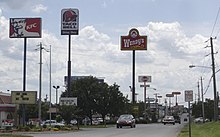

As automobiles became popular and affordable following the First World War, drive-in restaurants were introduced. The American company White Castle, founded by Billy Ingram and Walter Anderson in Wichita, Kansas in 1921, is generally credited with opening the second fast food outlet and first hamburger chain, selling hamburgers for five cents each. Walter Anderson had built the first White Castle restaurant in Wichita in 1916, introducing the limited menu, high volume, low cost, high speed hamburger restaurant. Among its innovations, the company allowed customers to see the food being prepared. White Castle was successful from its inception and spawned numerous competitors.
Franchising was introduced in 1921 by A&W Root Beer, which franchised its distinctive syrup. Howard Johnson's first franchised the restaurant concept in the mid-1930s, formally standardizing menus, signage and advertising.
Curb service was introduced in the late 1920s and was mobilized in the 1940s when carhops strapped on roller skates.
The United States has the largest fast food industry in the world, and American fast food restaurants are located in over 100 countries. Approximately 2 million U.S. workers are employed in the areas of food preparation and food servicing including fast food in the USA.[
On the go
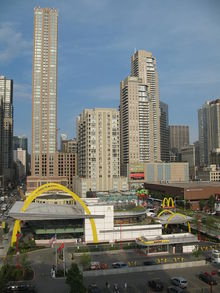
Fast food outlets are take-away or take-out providers, often with a "drive-through" service which allows customers to order and pick up food from their cars; but most also have a seating area in which customers can eat the food on the premises.
Nearly from its inception, fast food has been designed to be eaten "on the go", often does not require traditional cutlery, and is eaten as a finger food. Common menu items at fast food outlets include fish and chips, sandwiches, pitas, hamburgers, fried chicken, french fries, chicken nuggets, tacos, pizza, hot dogs, and ice cream, although many fast food restaurants offer "slower" foods like chili, mashed potatoes, and salads.
Filling stations
Many petrol/gas stations have convenience stores which sell pre-packaged sandwiches, doughnuts, and hot food. Many gas stations in the United States also sell frozen foods and have microwaves on the premises in which to prepare them.
Street vendors and concessions
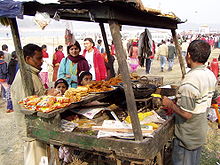
Traditional street food is available around the world, usually from small operators and independent vendors operating from a cart, table, portable grill or motor vehicle. Common examples include Vietnamese noodle vendors, Middle Eastern falafel stands, New York City hot dog carts, and taco trucks. Turo-Turo vendors (Tagalog for point point) are a feature of Philippine life. Commonly, street vendors provide a colorful and varying range of options designed to quickly captivate passers-by and attract as much attention as possible.
Depending on the locale, multiple street vendors may specialize in specific types of food characteristic of a given cultural or ethnic tradition. In some cultures, it is typical for street vendors to call out prices, sing or chant sales-pitches, play music, or engage in other forms of "street theatrics" in order to engage prospective customers. In some cases, this can garner more attention than the food itself; some vendors represent another form of tourist attraction.
Cuisine

Modern commercial fast food is often highly processed and prepared in an industrial fashion, i.e., on a large scale with standard ingredients and standardized cooking and production methods. It is usually rapidly served in cartons or bags or in a plastic wrapping, in a fashion which minimizes cost. In most fast food operations, menu items are generally made from processed ingredients prepared at a central supply facility and then shipped to individual outlets where they are reheated, cooked (usually by microwave or deep frying) or assembled in a short amount of time. This process ensures a consistent level of product quality, and is key to being able to deliver the order quickly to the customer and eliminate labor and equipment costs in the individual stores.
Because of commercial emphasis on speed, uniformity and low cost, fast food products are often made with ingredients formulated to achieve a certain flavor or consistency and to preserve freshness.
Variants
Although fast food often brings to mind traditional American fast food such as hamburgers and fries, there are many other forms of fast food that enjoy widespread popularity in the West.
Chinese takeaways/takeout restaurants are particularly popular. They normally offer a wide variety of Asian food (not always Chinese), which has normally been fried. Most options are some form of noodles, rice, or meat. In some cases, the food is presented as a smörgåsbord, sometimes self service. The customer chooses the size of the container they wish to buy, and then is free to fill it with their choice of food. It is common to combine several options in one container, and some outlets charge by weight rather than by item. Many of these restaurants offer free delivery for purchases over a minimum amount.

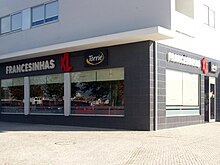
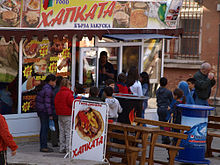
Sushi has seen rapidly rising popularity in recent times. A form of fast food created in Japan (where bentō is the Japanese equivalent of fast food), sushi is normally cold sticky rice flavored with a sweet rice vinegar and served with some topping (often fish), or, as in the most popular kind in the West, rolled in nori (dried laver) with filling. The filling often includes fish, chicken or cucumber.
Pizza is a common fast food category in the United States, with chains such as Papa John's, Domino's Pizza, Sbarro and Pizza Hut. Menus are more limited and standardized than in traditional pizzerias, and pizza delivery, often with a time commitment, is offered.
Kebab houses are a form of fast food restaurant from the Middle East, especially Turkey and Lebanon. Meat is shaven from a rotisserie, and is served on a warmed flatbread with salad and a choice of sauce and dressing. These doner kebabs or shawarmas are distinct from shish kebabs served on sticks. Kebab shops are also found throughout the world, especially Europe, New Zealand and Australia but they generally are less common in the US.
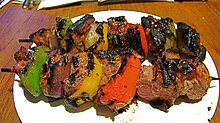
Fish and chip shops are a form of fast food popular in the United Kingdom, Australia and New Zealand. Fish is battered and then deep fried.
The Dutch have their own types of fast food. A Dutch fast food meal often consists of a portion of french fries (called friet or patat) with a sauce and a meat product. The most common sauce to accompany french fries is mayonnaise, while others can be ketchup or spiced ketchup, peanut sauce or piccalilli. Sometimes the fries are served with combinations of sauces, most famously speciaal (special): mayonnaise, with (spiced) ketchup and chopped onions; and oorlog (literally "war"): mayonnaise and peanut sauce (sometimes also with ketchup and chopped onions). The meat product is usually a deep fried snack; this includes the frikandel (a deep fried skinless minced meat sausage), and the kroket (deep fried meat ragout covered in breadcrumbs).
In Portugal, there are some varieties of local fast-food and restaurants specialized in this type of local cuisine. Some of the most popular foods include the popular frango assado (Piri-piri grilled chicken previously marinated), francesinha, francesinha poveira, espetada (succulent turkey or pork meat on two sticks) and bifanas (pork cutlets in a specific sauce served as a sandwich). This type of food is also often served with french fries (called batatas fritas), some international chains started appearing specialized in some of the typical Portuguese fast food such as Nando's.
Business
In the United States alone, consumers spent about US$110 billion on fast food in 2000 (which increased from US$6 billion in 1970). The National Restaurant Association forecasted that fast food restaurants in the U.S. would reach US$142 billion in sales in 2006, a 5% increase over 2005. In comparison, the full-service restaurant segment of the food industry is expected to generate $173 billion in sales. Fast food has been losing market share to fast casual dining restaurants, which offer more robust and expensive cuisines.
Globalization

In 2006, the global fast food market grew by 4.8% and reached a value of 102.4 billion and a volume of 80.3 billion transactions. In India alone the fast food industry is growing by 41% a year.
McDonald's is located in 126 countries and on 6 continents and operates over 31,000 restaurants worldwide. On January 31, 1990 McDonald’s opened a restaurant in Moscow, and broke opening day records for customers served. The Moscow restaurant is the busiest in the world. The largest McDonald’s in the world is located in Beijing, People's Republic of China.
There are numerous other fast food restaurants located all over the world. Burger King has more than 11,100 restaurants in more than 65 countries. KFC is located in 25 countries. Subway is one of the fastest growing franchises in the world with approximately 39,129 restaurants in 90 countries as of May 2009, the first non-US location opening in December 1984 in Bahrain. Pizza Hut is located in 97 countries, with 100 locations in China. Taco Bell has 278 restaurants located in 12 countries besides the United States.
Criticism
Fast food chains have come under fire from consumer groups, such as the Center for Science in the Public Interest, a longtime fast food critic over issues such as caloric content, trans fats and portion sizes. In 2001, Eric Schlosser's investigative work Fast Food Nation provided Americans with a detailed look at the culture of fast food from rangeland to the range top. In 2008, Caesar Barber attempted to sue a number of fast food restaurant chains for making him obese. The suit never went to court. Social scientists have highlighted how the prominence of fast food narratives in popular urban legends suggests that modern consumers have an ambivalent relationship (characterized by guilt) with fast food, particularly in relation to children. This guilt is projected onto processed food, where bizarre tales of contamination and lax standards are widely believed.
Some of the concerns have led to the rise of the Slow Food, or local food movements. These movements seek to preserve local cuisines and ingredients, and directly oppose laws and habits that favor fast food choices. Proponents of the slow food movement try to educate consumers about what its members considers the richer, more varied and more nourishing tastes of fresh, local ingredients that have been recently harvested. In Japan, the emphasis is instead on education about food nutrition and production, called shokuiku. The government does not campaign against personal decisions but ensures that every citizen understands where their food comes from.
Health issues
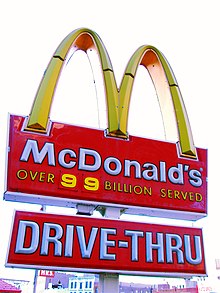
According to the Massachusetts Medical Society Committee on Nutrition, fast food is especially high in fat content, and studies have found associations between fast food intake and increased body mass index (BMI) and weight gain. A 2006 study fed monkeys a diet consisting of a similar level of trans fats as what a person who ate fast food regularly would consume. Both diets contained the same overall number of calories. It was found that the monkeys who consumed higher level of trans fat developed more abdominal fat than those fed a diet rich in unsaturated fats. They also developed signs of insulin resistance, which is an early indicator of diabetes. After six years on the diet, the trans fat fed monkeys had gained 7.2% of their body weight, compared to just 1.8% in the unsaturated fat group.
The director of the obesity program for the Children's Hospital Boston, David Ludwig, claims that "fast food consumption has been shown to increase calorie intake, promote weight gain, and elevate risk for diabetes". The Centers for Disease Control and Prevention ranked obesity as the number one health threat for Americans in 2003. It is the second leading cause of preventable death in the United States and results in 400,000 deaths each year. About 60 million American adults are classified as being obese with another 127 million being overweight. Health issues associated with obesity causes economic despair regarding health care. According to a 2003 study conducted by RTI International in North Carolina, the cost of health care in America is said to increase by $93 billion a year, mainly from Type 2 diabetes and heart disease, both associated with obesity.
Excessive calories are another issue with fast food. According to B. Lin and E. Frazao, from the Department of Agriculture, states the percentage of calories which attribute to fast-food consumption has increased from 3% to 12% of the total calories consumed in the United States. A regular meal at McDonald's consists of a Big Mac, large fries, and a large Coca-Cola drink amounting to 1,430 calories. A diet of approximately 2,000 calories is considered a healthy amount of calories for an entire day (which is different depending on several factors such as age, weight, height, physical activity and gender).
Besides the dangers of trans fats, high calories, and low fiber, there is another health risk: food poisoning. In his book Fast Food Nation: The Dark Side of the All-American Meal, Eric Schlosser describes in gross detail the process of meatpacking. Meatpacking has become one of the most hazardous jobs in America, with the risk of injury being three times higher than any other factory work. The meatpacking factories concentrate livestock into large feedlots and herd them through processing assembly lines operated by poorly trained employees increase the risk of large-scale food poisoning. Manure gets mixed with meat, contaminating it with salmonella and Escherichia coli 0157:H7. E. coli 0157:H7 is one of the worst forms of food poisoning. Usually spread through undercooked hamburgers, it is difficult to treat. Although antibiotics kill the bacteria, they release a toxin that produces hurtful complications. About 4% of people infected with E. coli 0157:H7 develop hemolytic uremic syndrome, and about 5% of children who develop the syndrome die. E. coli 0157:H7 has become the leading cause of renal failure among American kids.
In a research experiment done by Pediatrics, 6,212 children and adolescents ages 4 to 19 years old were examined to find out some information about fast food. After interviewing the participants in the experiment, it was discovered that on a given day 30.3% of the total sample have reported to have eaten fast food. Fast-food consumption was prevalent in both males and females, all racial/ethnic groups, and all regions of the country. Children who ate fast food, compared with those who did not, consumed more total fat, carbohydrates, and sugar-sweetened beverages. Children who ate fast food also ate less fiber, milk, fruits, and non-starchy vegetables. After reviewing these test results, the researchers concluded that consumption of fast food by children seems to have a negative effect on an individual's diet, in ways that could significantly increase the risk for obesity. On average nearly one-third of U.S children aged 4 to 19 eat fast food on a daily basis. Over the course of a year this bad habit is likely to result in the child gaining six extra pounds every year
No comments:
Post a Comment